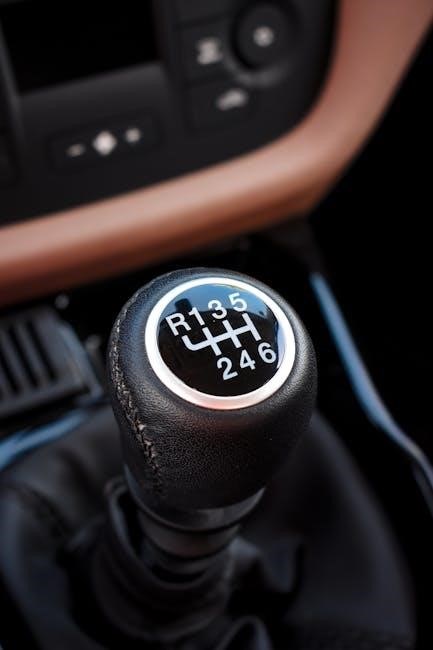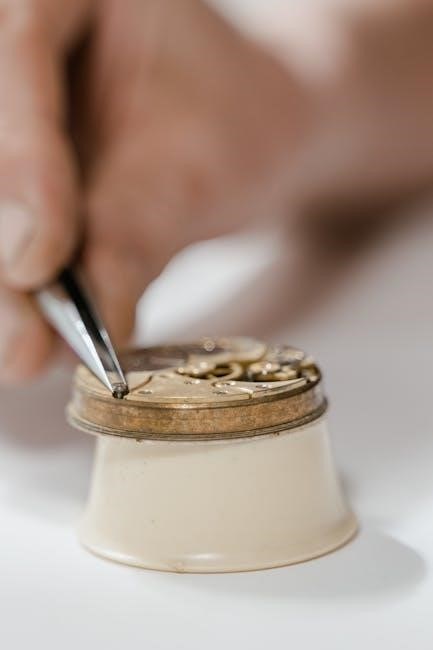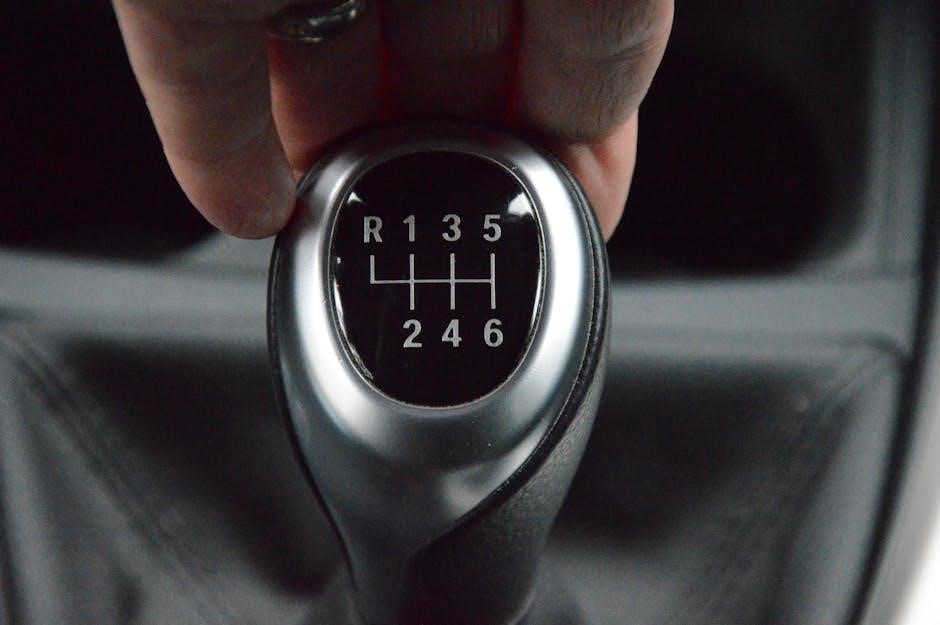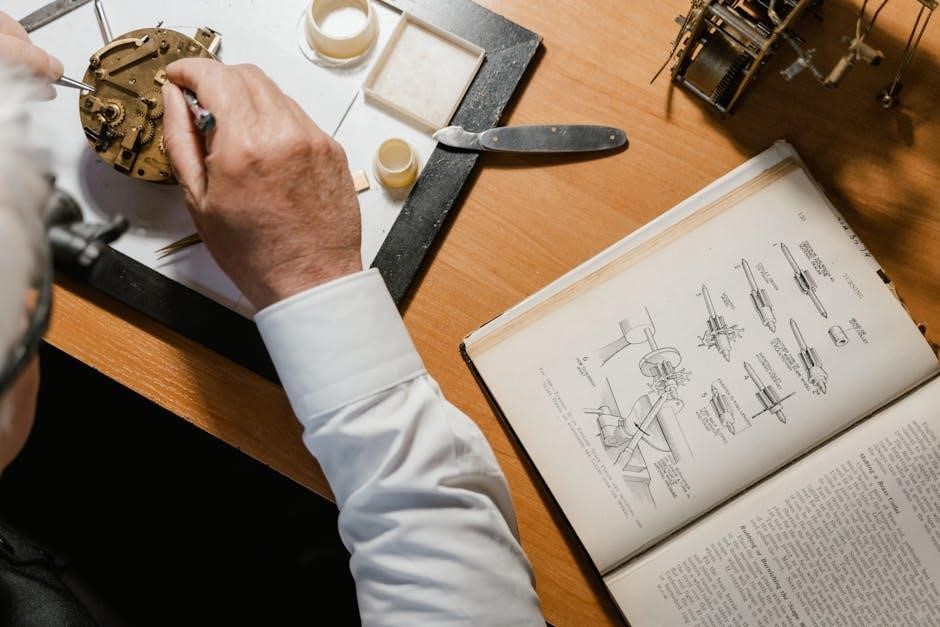Manual transmissions are known for their reliability, but issues like jumping out of gear can occur due to misaligned linkages or worn components, requiring immediate attention.
1.1 Definition of Manual Transmission Jumping Out of Gear
Manual transmission jumping out of gear refers to when the transmission unexpectedly disengages from the selected gear, often slipping into neutral or another gear without driver input. This issue, also known as “gearing out,” can occur during acceleration, deceleration, or while shifting gears. It is commonly caused by poorly adjusted gearbox linkages or worn-out components like the clutch or gear selector forks. If left unaddressed, it can lead to further damage to the transmission system; This problem can affect both new and older vehicles, especially if proper maintenance is neglected. Addressing it promptly is crucial to avoid more severe complications.
1.2 Importance of Addressing the Issue
Addressing the issue of a manual transmission jumping out of gear is crucial for maintaining vehicle safety and performance. If ignored, it can lead to sudden loss of control, especially during high-speed driving or when navigating challenging road conditions. Additionally, prolonged neglect may result in costly damage to transmission components, such as gears, bearings, and synchros, potentially requiring a full transmission rebuild. Fixing the problem promptly ensures smoother shifting, prevents further mechanical wear, and enhances overall driving safety. Regular maintenance and timely repairs are essential to avoid these risks and maintain the reliability of the vehicle’s transmission system.

Common Causes of Manual Transmission Jumping Out of Gear
Poorly adjusted gearbox linkages, worn clutch components, misaligned gear selector forks, insufficient lubrication, and driver error are common causes of manual transmissions jumping out of gear.
2.1 Poorly Adjusted Gearbox Linkages
Poorly adjusted gearbox linkages are a leading cause of manual transmissions jumping out of gear. When linkages are misaligned, gears may not fully engage, causing the transmission to slip into neutral or other gears unexpectedly. This issue often arises after recent repairs or if the linkage has been tampered with. Proper adjustment ensures smooth gear engagement and prevents sudden shifts. If left unchecked, it can lead to further damage, emphasizing the need for regular inspections and timely adjustments. Addressing this issue early helps maintain transmission reliability and driver control.
2.2 Worn-Out Clutch Components
Worn-out clutch components can contribute to a manual transmission jumping out of gear. The clutch plays a critical role in holding the engine’s power during gear shifts. When the clutch disc, pressure plate, or release bearing wears out, it can cause the transmission to slip or disengage unexpectedly. This often happens during acceleration or when shifting gears, as the worn components fail to maintain proper engagement. Over time, this can lead to difficulty in controlling the vehicle, especially in heavy traffic or uphill driving. Inspecting and replacing worn clutch parts is essential to restore smooth gear transitions and prevent further issues.
2.3 Misaligned or Damaged Gear Selector Forks
Misaligned or damaged gear selector forks are a common cause of a manual transmission jumping out of gear. The gear selector forks are responsible for engaging and disengaging gears within the transmission. If they become misaligned or worn, they may fail to properly lock into the desired gear, causing the transmission to slip or jump out of gear unexpectedly. This issue can occur due to wear over time or physical damage from improper shifting techniques. Symptoms include difficulty engaging gears and a “slipping” sensation while driving. Inspecting and repairing or replacing the gear selector forks is essential to restore proper transmission function.
2.4 Insufficient Lubrication in the Transmission
Insufficient lubrication in the transmission is a critical factor that can cause a manual transmission to jump out of gear. Transmission fluid plays a vital role in reducing friction and preventing overheating of moving components. When lubrication levels are low, gears may not engage smoothly, leading to slipping or unexpected disengagement. Over time, this can result in excessive wear on gears and other internal components. Symptoms of insufficient lubrication include grinding noises during shifting and difficulty maintaining gear engagement. Regularly checking and maintaining proper lubrication levels is essential to prevent this issue and ensure smooth transmission operation.
2.5 Driver Error and Improper Shifting Techniques
Driver error and improper shifting techniques are common causes of a manual transmission jumping out of gear. Aggressive shifting, such as shifting too quickly or applying excessive force, can strain the gearbox and cause gears to disengage unexpectedly. Additionally, failing to press the clutch fully or “riding the clutch” can lead to improper gear engagement, increasing the likelihood of the transmission slipping out of gear. Inexperienced drivers are particularly prone to these issues, as they may not yet master smooth and precise shifting. Proper training and adherence to correct driving techniques can significantly reduce the risk of such problems.

Symptoms of a Manual Transmission Jumping Out of Gear
Common symptoms include sudden gear drops, unexpected shifts into neutral, and increased engine RPM without speed changes, signaling potential issues with the transmission system.
3.1 Random Dropping into Neutral or Other Gears
One common symptom is the transmission randomly dropping into neutral or other gears without warning. This can happen during acceleration or deceleration, causing loss of power and control. Such incidents often result from issues like misaligned gearbox linkages or worn clutch components, which prevent proper gear engagement. If left unaddressed, this problem may lead to further damage, such as worn synchronizers or gear teeth. Regular inspection and maintenance are crucial to identify and fix these issues early, ensuring the transmission operates smoothly and safely. Drivers should pay attention to any unexpected shifts, as they indicate underlying mechanical problems.
3.2 Grinding or Clunking Noises During Shifting
Grinding or clunking noises during shifting are indicative of mechanical issues within the transmission. These sounds often occur when gears do not engage smoothly, which can be caused by worn-out synchronizers, damaged gear teeth, or insufficient lubrication. If the gearbox linkages are misaligned, it can also lead to improper gear engagement, resulting in these noises. Drivers may notice these sounds more prominently when shifting into specific gears, such as first or reverse. Persistent noises should not be ignored, as they can signal deeper problems that may lead to the transmission jumping out of gear unexpectedly. Addressing these issues promptly is essential to prevent further damage.
3.3 Loss of Control Over Gear Selection
Loss of control over gear selection is a critical symptom when a manual transmission jumps out of gear. This occurs when the driver’s ability to maintain the selected gear is compromised, often due to worn or damaged components like the clutch, gear selector forks, or linkages. The transmission may slip into neutral or another gear unexpectedly, especially during acceleration or deceleration. This sudden loss of control can lead to a lack of power delivery, making it difficult to maintain speed or accelerate safely. Such incidents increase the risk of accidents, particularly in high-traffic situations, and necessitate immediate mechanical inspection. Timely repair is crucial to restore driver control and ensure safe vehicle operation.
3.4 Increased Engine RPM Without Speed Increase
When a manual transmission jumps out of gear, the engine RPM may surge without a corresponding increase in vehicle speed. This happens because the gear disengages, causing the engine to rev freely without transferring power to the wheels. Drivers may notice a sudden rise in RPM on the tachometer, accompanied by a loss of acceleration. This symptom often occurs during acceleration from a standstill or when shifting between gears. It can indicate issues such as worn synchronizers, faulty clutch components, or misaligned gear selector forks. Addressing this problem promptly is essential to prevent further damage to the transmission and ensure smooth power delivery. Regular maintenance and timely repairs can help mitigate such issues.

Diagnosis of the Problem
Diagnosing a manual transmission that jumps out of gear involves a combination of visual inspections, test driving, and using specialized tools to identify faulty components like linkages or clutch parts.
4.1 Visual Inspection of Transmission Components
A visual inspection is the first step in diagnosing a manual transmission jumping out of gear. Mechanics examine components like gearbox linkages, selector forks, and clutch parts for wear or damage. Misaligned or corroded linkages can prevent gears from engaging properly, while worn synchros or damaged forks may cause unexpected shifting. Inspecting these areas helps pinpoint issues before moving to more invasive testing, ensuring a targeted repair approach and minimizing unnecessary costs. This step is crucial for identifying physical damage that could lead to gear slippage or disengagement. Regular visual checks can also prevent minor issues from escalating into major problems.
4.2 Test Driving to Replicate the Issue
Test driving is essential to replicate and understand the behavior of a manual transmission jumping out of gear. By simulating real-world conditions, such as accelerating, decelerating, and shifting through gears, technicians can observe when and how the issue occurs. This step helps identify patterns, like specific gears or speeds where the problem manifests, which are critical for accurate diagnosis. Test driving also allows mechanics to assess the consistency of the issue and determine if it’s related to driver input or mechanical failure. Replicating the problem under controlled conditions ensures effective troubleshooting and targeted repairs. This step is vital for resolving gear-related issues efficiently.
4.3 Use of Diagnostic Tools for Transmission Analysis
Diagnostic tools play a crucial role in analyzing manual transmission issues, particularly when the transmission jumps out of gear. Modern diagnostic equipment can monitor gear engagement sensors, transmission fluid pressure, and clutch actuation, providing real-time data. Scan tools may reveal fault codes related to sensor malfunctions or solenoid issues. Additionally, endoscopes can visually inspect internal components like gear selector forks and synchros without disassembling the transmission. These tools help pinpoint the root cause, whether it’s mechanical wear, electrical failure, or hydraulic system issues. By leveraging advanced diagnostics, technicians can efficiently identify and address the problem, ensuring a precise and effective repair. This approach minimizes guesswork and reduces repair time.

Consequences of Ignoring the Issue
Ignoring a manual transmission that jumps out of gear can lead to severe damage, including broken gears and synchronizers, costly repairs, and potential safety hazards while driving.
5.1 Damage to Transmission Components
Ignoring the issue of a manual transmission jumping out of gear can cause significant damage to internal components. Worn clutch parts and misaligned gear forks may lead to gears not engaging properly, resulting in increased wear on synchronizers and gear teeth. Over time, this can cause gears to crack or break, requiring costly repairs. Additionally, inadequate lubrication can exacerbate wear, leading to premature failure of bearings and other critical parts. Addressing the problem early is crucial to prevent further damage and ensure the transmission operates smoothly for years to come. Regular maintenance can help identify such issues before they escalate.
5.2 Increased Risk of Accidents Due to Loss of Control
When a manual transmission unexpectedly jumps out of gear, drivers lose control over vehicle speed and acceleration, significantly increasing the risk of accidents. This sudden loss of control can occur during critical driving moments, such as merging onto highways or navigating steep inclines. If the transmission drops into neutral or another gear without warning, the vehicle may decelerate rapidly, catching the driver off guard. This unpredictability can lead to rear-end collisions or inability to maintain safe speeds, especially in heavy traffic. The risk is heightened in situations requiring precise speed control, making immediate repair essential to ensure safe operation and prevent potential accidents.
5.3 Higher Repair Costs Over Time
Ignoring a manual transmission that jumps out of gear can lead to more extensive and costly damage over time. Initially, the issue might seem minor, but prolonged neglect allows wear and tear to escalate. Components like gear selector forks, linkages, and clutch parts may deteriorate further, requiring more complex repairs. If the transmission is not addressed, it can lead to failure of critical internal components, such as gears and bearings, which are expensive to replace. Additionally, secondary damage to related systems, such as the drivetrain, can occur, compounding repair costs. Addressing the issue early prevents these financial burdens.
Solutions for Manual Transmission Jumping Out of Gear
Addressing the issue involves adjusting gearbox linkages, replacing worn clutch or transmission parts, and ensuring proper lubrication to restore smooth gear engagement and prevent further damage.
6.1 Adjusting Gearbox Linkages
Adjusting gearbox linkages is a critical step in resolving gear slippage. Proper alignment ensures gears engage smoothly, preventing unintended shifts. Mechanics often tighten or replace loose connections. This adjustment can significantly improve transmission performance and reliability, reducing the risk of further issues. It’s a cost-effective solution compared to replacing entire components. Regular checks are recommended to maintain optimal functionality and prevent future problems.
6.2 Replacing Worn-Out Clutch or Transmission Parts
Replacing worn-out clutch or transmission parts is essential to prevent further damage and restore proper gear engagement. Over time, components like the clutch disc, pressure plate, or gear synchronizers can wear out, leading to gear slippage. Replacing these parts ensures smooth shifting and eliminates the risk of sudden disengagement. It’s crucial to use high-quality replacement parts and follow proper installation procedures. Regular inspections can help identify wear early, preventing costly repairs down the line. Addressing these issues promptly ensures driver safety and maintains the vehicle’s overall performance. Professional mechanics often recommend this as a reliable long-term solution.
6.3 Repairing or Replacing Gear Selector Forks
Gear selector forks play a critical role in engaging gears within the transmission. If they are misaligned or damaged, gears may not engage properly, leading to unexpected shifts. Repairing or replacing these forks ensures precise gear selection and smooth operation. This process typically involves disassembling the transmission to access the forks, inspecting for wear or damage, and replacing them with new components. Proper alignment and adjustment are crucial to prevent future issues. While this repair can be complex, it effectively addresses the root cause of gear jumping, restoring control and reliability to the manual transmission system. Regular maintenance can help prevent such issues.
6.4 Ensuring Proper Lubrication Levels
Proper lubrication is essential for smooth transmission operation. Inadequate fluid levels can cause gears to wear, overheat, and fail to engage correctly, leading to unexpected shifts. Regular checks and timely top-ups ensure optimal viscosity and temperature control, preventing premature wear. Using the correct specification of transmission fluid is crucial for maintaining gear integrity and system performance. Neglecting lubrication can result in costly repairs, including gear replacement. Consistent maintenance not only enhances reliability but also extends the lifespan of the manual transmission, ensuring it operates efficiently and avoids issues like jumping out of gear.

Preventative Measures
Regular maintenance, proper shifting techniques, and inspections ensure smooth manual transmission operation, preventing unexpected gear shifts and potential damage. Consistent care extends transmission lifespan and reliability.
7.1 Regular Maintenance of Transmission and Clutch
Regular maintenance is crucial for preventing manual transmission issues. Checking and replacing the clutch components, gearbox linkages, and ensuring proper lubrication levels can prevent gears from misaligning or slipping. Inspecting the clutch cable or hydraulic system for wear ensures smooth engagement. Lubricating the transmission with the correct fluid maintains internal components’ health. Additionally, examining the gear selector forks and transmission mounts for damage or wear can address potential problems early. Consistent upkeep reduces the risk of sudden gear shifts and prolongs the lifespan of the transmission, saving costs and ensuring reliable performance. Regular maintenance is key to avoiding unexpected issues.
7.2 Proper Driver Training and Shifting Techniques
Proper driver training and shifting techniques play a significant role in preventing manual transmissions from jumping out of gear. Instruction on smooth acceleration, gradual clutch engagement, and avoiding aggressive downshifting can minimize wear on components. Educating drivers on the importance of using the clutch fully and not riding it reduces stress on the gearbox. Teaching correct gear selection for speed and load helps prevent misalignment. Additionally, training drivers to avoid sudden shifts or over-revving ensures consistent engagement. Proper techniques not only enhance control but also protect the transmission from premature wear, contributing to overall vehicle safety and performance. Regular practice reinforces these habits.
7.4 Inspecting Transmission Mounts for Damage
Inspecting transmission mounts is crucial for maintaining stability and preventing gear issues. Worn or damaged mounts can cause misalignment, leading to improper gear engagement and potential jumping out of gear. Regularly check for signs of wear, such as cracks or excessive movement, and replace mounts if necessary. Secure mounts ensure the transmission stays in position, reducing stress on linkages and gears. This simple maintenance step can prevent more serious problems and ensure smooth shifting. Addressing mount damage early helps maintain control and extends the lifespan of transmission components. Regular inspections are a proactive way to avoid costly repairs down the line.
Addressing manual transmission issues promptly is essential for safety and longevity. Regular maintenance and proper driving techniques can prevent gears from jumping out, ensuring smooth operation.
8.1 Summary of Key Points
Manual transmission jumping out of gear is often caused by misaligned linkages, worn components, or improper shifting. It can lead to unsafe driving conditions and costly repairs if ignored. Regular maintenance, such as checking lubrication levels and inspecting gear forks, is crucial. Drivers should avoid aggressive shifting and ensure proper clutch usage. Addressing the issue early prevents further damage and ensures smooth operation. Consulting a mechanic is recommended for accurate diagnosis and repair. Prioritizing transmission health enhances vehicle performance and safety on the road. Consistent care helps maintain the longevity of manual transmissions. Prompt action is essential.
8.2 Final Recommendations for Car Owners
Car owners should prioritize regular transmission maintenance to prevent gear issues. Ensure gearbox linkages are properly adjusted and lubrication levels are optimal. Replace worn clutch components promptly. Practice smooth shifting techniques to reduce wear. If the transmission jumps out of gear, avoid driving and consult a mechanic immediately. Regular inspections of gear forks and mounts can prevent major repairs. Investing in preventive care enhances safety and vehicle longevity. Stay informed about transmission health through resources and forums. Addressing problems early saves time and money, ensuring reliable performance and safety on the road. Consistent upkeep is key to avoiding transmission failure.

Additional Resources
For further guidance, explore DIY repair forums, manufacturer manuals, and instructional videos on manual transmission maintenance and troubleshooting common issues like gears slipping out unexpectedly.
9.1 Recommended Tools for DIY Transmission Repair
Essential tools for DIY transmission repair include a socket set, torque wrench, and gear puller. A hydraulic clutch kit can help replace worn clutch components, while a transmission jack ensures safe disassembly. O-ring and gasket sets are crucial for maintaining proper seals. A multimeter and diagnostic tools aid in identifying electrical issues, and a service manual provides step-by-step guidance. Proper lubricants, such as gear oil, are vital for maintaining transmission health. Using these tools can help diagnose and fix issues like misaligned linkages or worn-out components causing gears to slip.
9.2 Suggested Reading for Manual Transmission Maintenance
For a deeper understanding, consider reading “Manual Transmission Repair and Maintenance” by Haynes. This guide offers detailed instructions and troubleshooting tips. Additionally, “The Garage Manual” provides insights into common issues like gears slipping and offers practical solutions. Online forums and repair manuals specific to your vehicle model can also be invaluable. These resources cover essential topics such as lubrication, linkage adjustment, and clutch care, helping you address problems effectively and prevent future issues.

Frequently Asked Questions
Drivers often ask about causes, costs, and safety concerns regarding transmissions jumping out of gear. These questions highlight the importance of prompt repairs and proper maintenance;
10.1 Can a Manual Transmission Jump Out of Gear Due to Normal Wear and Tear?
Yes, a manual transmission can jump out of gear due to normal wear and tear. Over time, components like the clutch and gear selector forks can degrade, leading to this issue.
10.2 How Much Does It Typically Cost to Repair a Transmission That Jumps Out of Gear?
The cost to repair a transmission that jumps out of gear varies widely, depending on the cause. Minor adjustments or replacing worn parts might cost between $200 to $1,000. However, if major components like the gearbox or clutch need replacement, costs can escalate to $1,500 to $4,000 or more, especially if labor-intensive rebuilds are required.
10.3 Is It Safe to Drive a Car with a Transmission That Occasionally Jumps Out of Gear?
Driving a car with a transmission that occasionally jumps out of gear is not safe. This issue can lead to unexpected loss of control, especially during acceleration or shifting, increasing the risk of accidents. It can also cause further damage to transmission components, leading to more costly repairs. It is strongly recommended to avoid driving the vehicle until the problem is diagnosed and fixed by a professional mechanic to ensure safety on the road and prevent additional damage.